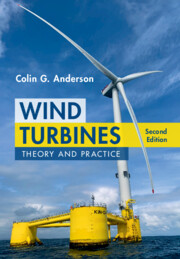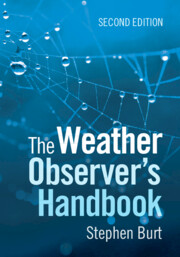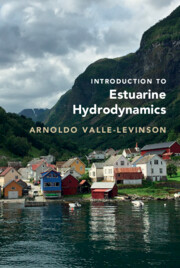Refine search
Actions for selected content:
43 results
9 - Geopolitics and Green Energy
-
- Book:
- The Great Disruption
- Published online:
- 05 June 2025
- Print publication:
- 19 June 2025, pp 225-252
-
- Chapter
- Export citation
On the effectiveness of neural operators at zero-shot weather downscaling
- Part of
-
- Journal:
- Environmental Data Science / Volume 4 / 2025
- Published online by Cambridge University Press:
- 27 March 2025, e21
-
- Article
-
- You have access
- Open access
- HTML
- Export citation
The Greening of China's Black Electric Power System? Insights from 2014 Data
-
- Journal:
- Asia-Pacific Journal / Volume 13 / Issue 11 / March 2015
- Published online by Cambridge University Press:
- 14 March 2025, e2
-
- Article
-
- You have access
- Open access
- Export citation

Wind Turbines
- Theory and Practice
-
- Published online:
- 24 January 2025
- Print publication:
- 19 December 2024
-
- Textbook
- Export citation
Chapter 2 - The Wind and Its Characteristics
-
- Book:
- Wind Turbines
- Published online:
- 24 January 2025
- Print publication:
- 19 December 2024, pp 13-32
-
- Chapter
- Export citation
Chapter 24 - Papa Loko’s Dire Poétique in Twenty-First-Century Port-au-Prince-Based Haitian Poetry
-
-
- Book:
- A History of Haitian Literature
- Published online:
- 07 November 2024
- Print publication:
- 21 November 2024, pp 428-443
-
- Chapter
- Export citation

The Weather Observer's Handbook
-
- Published online:
- 21 May 2024
- Print publication:
- 25 April 2024
3 - Buying a weather station
- from Part I - The basics
-
- Book:
- The Weather Observer's Handbook
- Published online:
- 21 May 2024
- Print publication:
- 25 April 2024, pp 58-84
-
- Chapter
- Export citation
2 - Choosing a weather station
- from Part I - The basics
-
- Book:
- The Weather Observer's Handbook
- Published online:
- 21 May 2024
- Print publication:
- 25 April 2024, pp 34-57
-
- Chapter
- Export citation
8 - Renewable Energy Transitions
- from Part II - Net-Zero-Carbon Transitions
-
- Book:
- Dynamic Sustainability
- Published online:
- 07 December 2023
- Print publication:
- 21 December 2023, pp 98-121
-
- Chapter
- Export citation
A review of wind-driven hydrodynamics in large shallow lakes: Importance, process-based modeling and perspectives
-
- Journal:
- Cambridge Prisms: Water / Volume 1 / 2023
- Published online by Cambridge University Press:
- 06 November 2023, e16
-
- Article
-
- You have access
- Open access
- HTML
- Export citation
Chapter 8 - The Ill Effect of South Winds on the Joints in the Human Body
- from Part III - Towards the Mechanization of the Human Body
-
-
- Book:
- Body and Machine in Classical Antiquity
- Published online:
- 13 July 2023
- Print publication:
- 27 July 2023, pp 203-217
-
- Chapter
- Export citation
Spatio-temporal monitoring of the iceberg D28 using SCATSAT-1 data
-
- Journal:
- Polar Record / Volume 59 / 2023
- Published online by Cambridge University Press:
- 19 April 2023, e15
-
- Article
- Export citation
A Review of the Progress and Potential of Energy Generation from Renewable Sources in Latin America
- Part of
-
- Journal:
- Latin American Research Review / Volume 58 / Issue 2 / June 2023
- Published online by Cambridge University Press:
- 20 March 2023, pp. 383-402
-
- Article
-
- You have access
- Open access
- HTML
- Export citation
Selected issues of optimising parameters on square riggers to maximise speed
-
- Journal:
- The Journal of Navigation / Volume 76 / Issue 2-3 / March 2023
- Published online by Cambridge University Press:
- 15 August 2023, pp. 153-180
- Print publication:
- March 2023
-
- Article
-
- You have access
- Open access
- HTML
- Export citation
Relation analysis of ship speed & environmental conditions: Can historic AIS data form a baseline for autonomous determination of safe speed?
-
- Journal:
- The Journal of Navigation / Volume 76 / Issue 2-3 / March 2023
- Published online by Cambridge University Press:
- 09 June 2023, pp. 340-374
- Print publication:
- March 2023
-
- Article
-
- You have access
- Open access
- HTML
- Export citation
Low-carbon Frontier: Renewable Energy and the New Resource Boom in Western China
-
- Journal:
- The China Quarterly / Volume 255 / September 2023
- Published online by Cambridge University Press:
- 25 November 2022, pp. 591-610
- Print publication:
- September 2023
-
- Article
-
- You have access
- Open access
- HTML
- Export citation
Chapter 19 - Energy Futures in Contemporary Irish Fiction
-
-
- Book:
- A History of Irish Literature and the Environment
- Published online:
- 14 July 2022
- Print publication:
- 28 July 2022, pp 377-394
-
- Chapter
- Export citation
Chapter 5 - Anthropology: Colonialism, Indigeneity, and Wind Power in the Anthropocene
- from Part Two - One Anthropocene; Many Stories
-
-
- Book:
- Altered Earth
- Published online:
- 24 March 2022
- Print publication:
- 31 March 2022, pp 130-146
-
- Chapter
- Export citation

Introduction to Estuarine Hydrodynamics
-
- Published online:
- 24 February 2022
- Print publication:
- 03 March 2022
